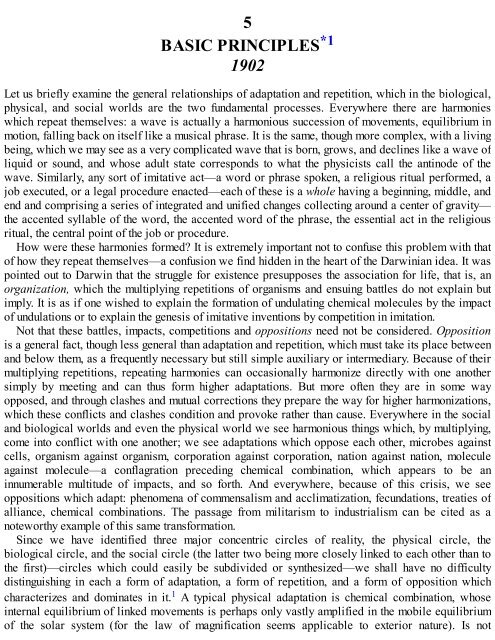3658925934
You also want an ePaper? Increase the reach of your titles
YUMPU automatically turns print PDFs into web optimized ePapers that Google loves.
5<br />
BASIC PRINCIPLES *1<br />
1902<br />
Let us briefly examine the general relationships of adaptation and repetition, which in the biological,<br />
physical, and social worlds are the two fundamental processes. Everywhere there are harmonies<br />
which repeat themselves: a wave is actually a harmonious succession of movements, equilibrium in<br />
motion, falling back on itself like a musical phrase. It is the same, though more complex, with a living<br />
being, which we may see as a very complicated wave that is born, grows, and declines like a wave of<br />
liquid or sound, and whose adult state corresponds to what the physicists call the antinode of the<br />
wave. Similarly, any sort of imitative act—a word or phrase spoken, a religious ritual performed, a<br />
job executed, or a legal procedure enacted—each of these is a whole having a beginning, middle, and<br />
end and comprising a series of integrated and unified changes collecting around a center of gravity—<br />
the accented syllable of the word, the accented word of the phrase, the essential act in the religious<br />
ritual, the central point of the job or procedure.<br />
How were these harmonies formed? It is extremely important not to confuse this problem with that<br />
of how they repeat themselves—a confusion we find hidden in the heart of the Darwinian idea. It was<br />
pointed out to Darwin that the struggle for existence presupposes the association for life, that is, an<br />
organization, which the multiplying repetitions of organisms and ensuing battles do not explain but<br />
imply. It is as if one wished to explain the formation of undulating chemical molecules by the impact<br />
of undulations or to explain the genesis of imitative inventions by competition in imitation.<br />
Not that these battles, impacts, competitions and oppositions need not be considered. Opposition<br />
is a general fact, though less general than adaptation and repetition, which must take its place between<br />
and below them, as a frequently necessary but still simple auxiliary or intermediary. Because of their<br />
multiplying repetitions, repeating harmonies can occasionally harmonize directly with one another<br />
simply by meeting and can thus form higher adaptations. But more often they are in some way<br />
opposed, and through clashes and mutual corrections they prepare the way for higher harmonizations,<br />
which these conflicts and clashes condition and provoke rather than cause. Everywhere in the social<br />
and biological worlds and even the physical world we see harmonious things which, by multiplying,<br />
come into conflict with one another; we see adaptations which oppose each other, microbes against<br />
cells, organism against organism, corporation against corporation, nation against nation, molecule<br />
against molecule—a conflagration preceding chemical combination, which appears to be an<br />
innumerable multitude of impacts, and so forth. And everywhere, because of this crisis, we see<br />
oppositions which adapt: phenomena of commensalism and acclimatization, fecundations, treaties of<br />
alliance, chemical combinations. The passage from militarism to industrialism can be cited as a<br />
noteworthy example of this same transformation.<br />
Since we have identified three major concentric circles of reality, the physical circle, the<br />
biological circle, and the social circle (the latter two being more closely linked to each other than to<br />
the first)—circles which could easily be subdivided or synthesized—we shall have no difficulty<br />
distinguishing in each a form of adaptation, a form of repetition, and a form of opposition which<br />
characterizes and dominates in it. 1 A typical physical adaptation is chemical combination, whose<br />
internal equilibrium of linked movements is perhaps only vastly amplified in the mobile equilibrium<br />
of the solar system (for the law of magnification seems applicable to exterior nature). Is not









![Genki - An Integrated Course in Elementary Japanese II [Second Edition] (2011), WITH PDF BOOKMARKS!](https://img.yumpu.com/58322134/1/180x260/genki-an-integrated-course-in-elementary-japanese-ii-second-edition-2011-with-pdf-bookmarks.jpg?quality=85)
![Genki - An Integrated Course in Elementary Japanese I [Second Edition] (2011), WITH PDF BOOKMARKS!](https://img.yumpu.com/58322120/1/182x260/genki-an-integrated-course-in-elementary-japanese-i-second-edition-2011-with-pdf-bookmarks.jpg?quality=85)





